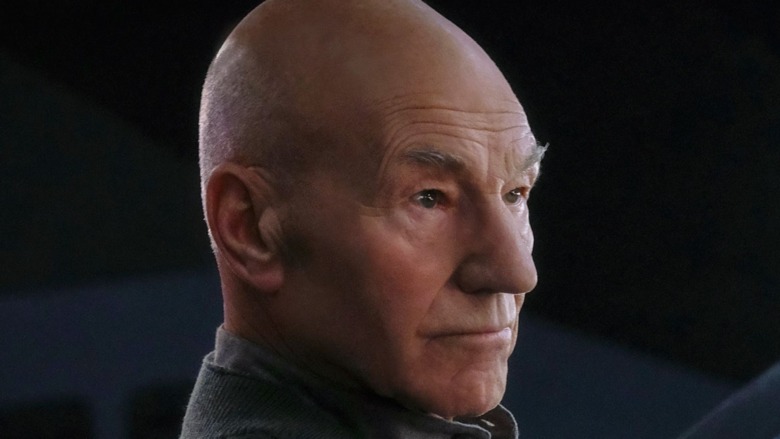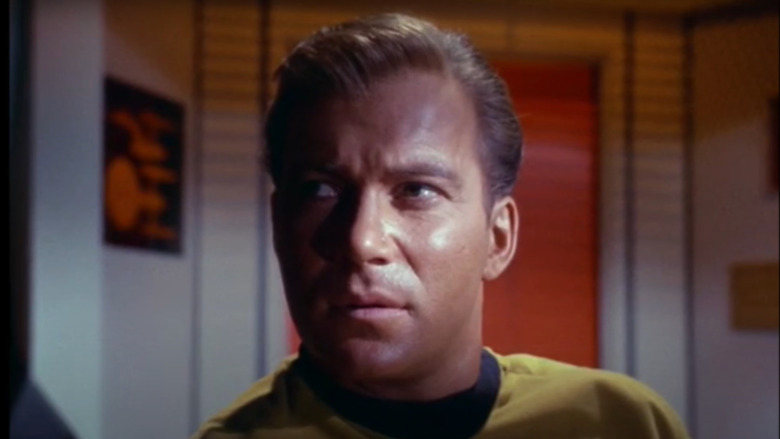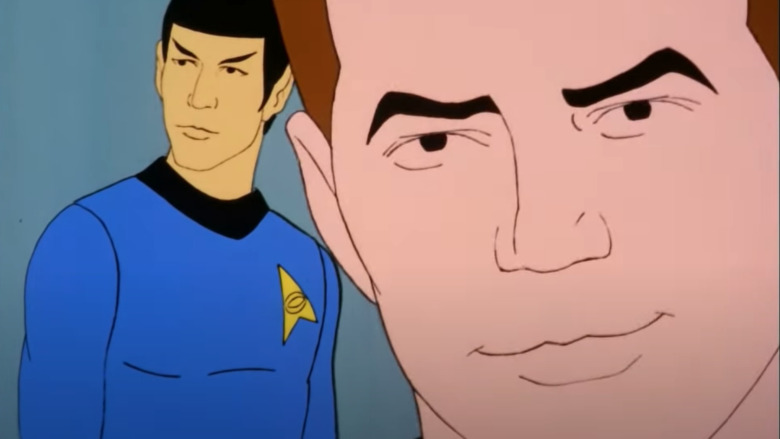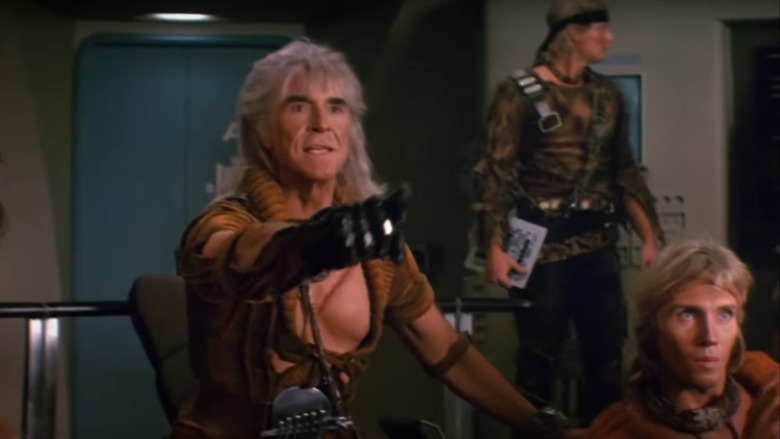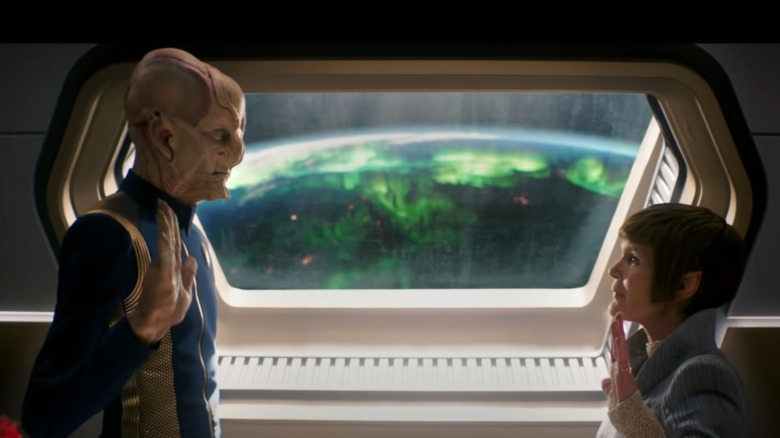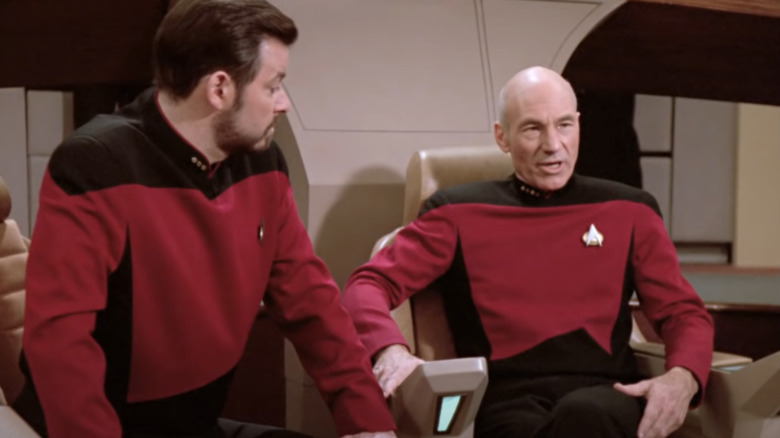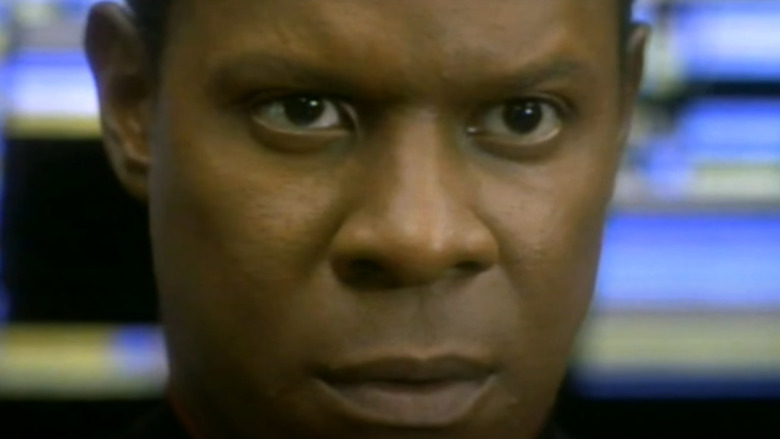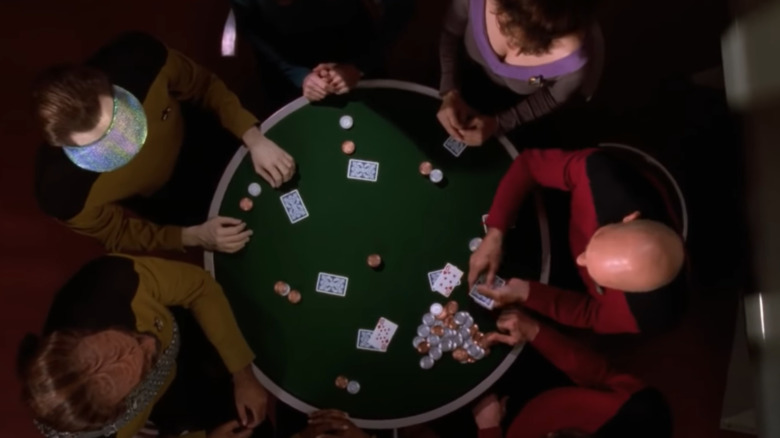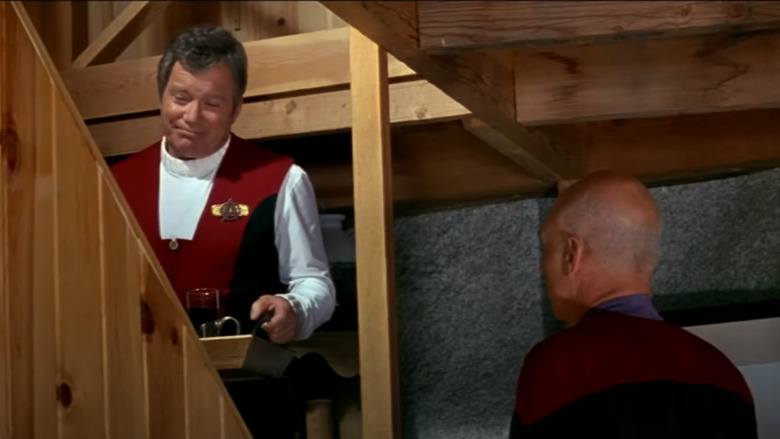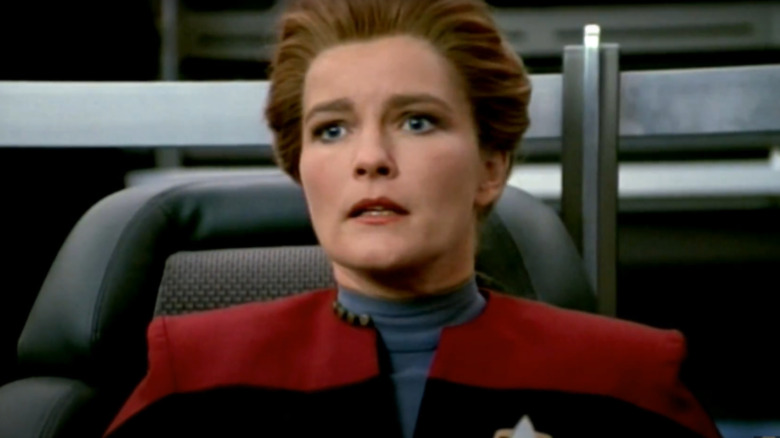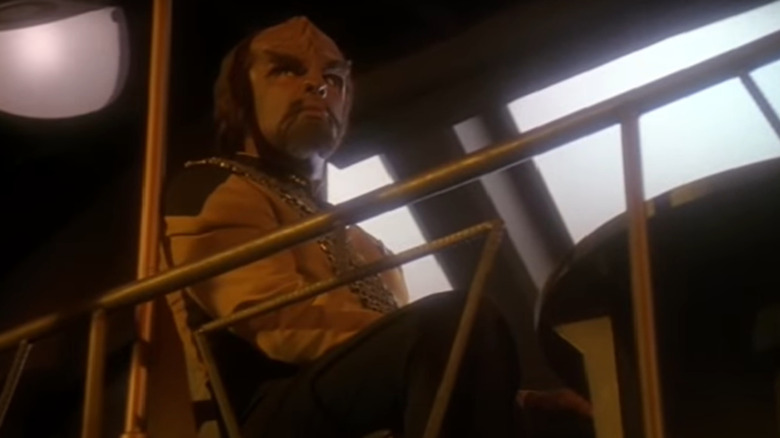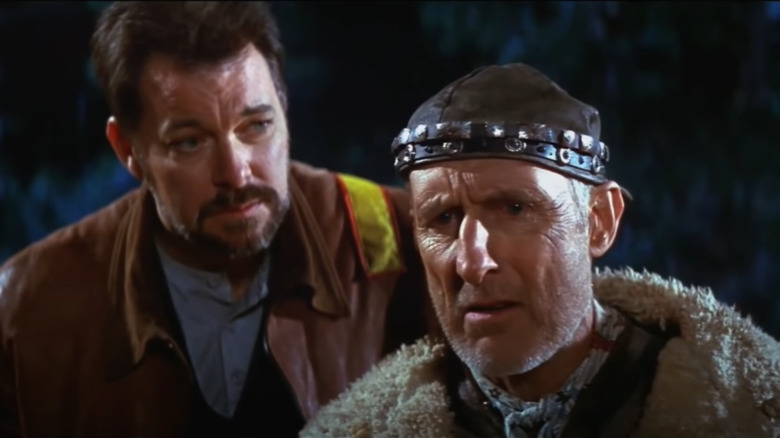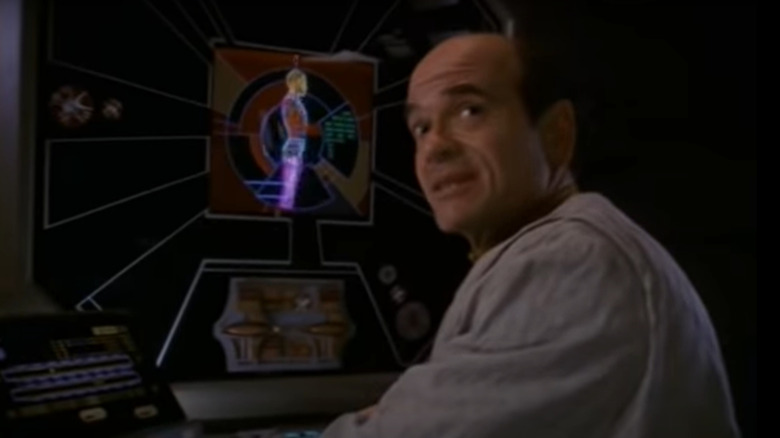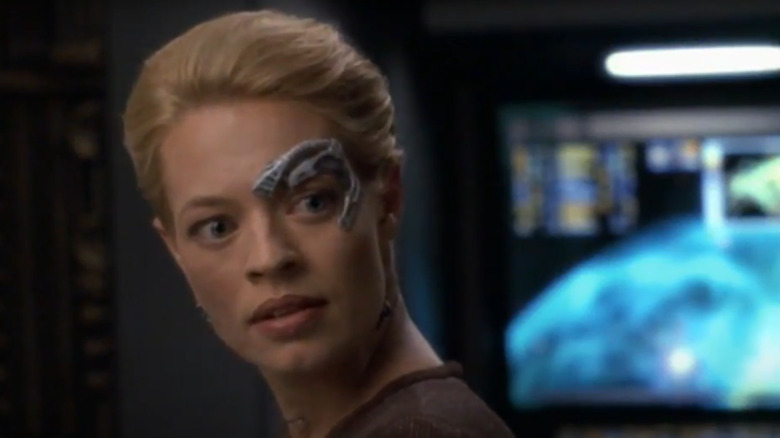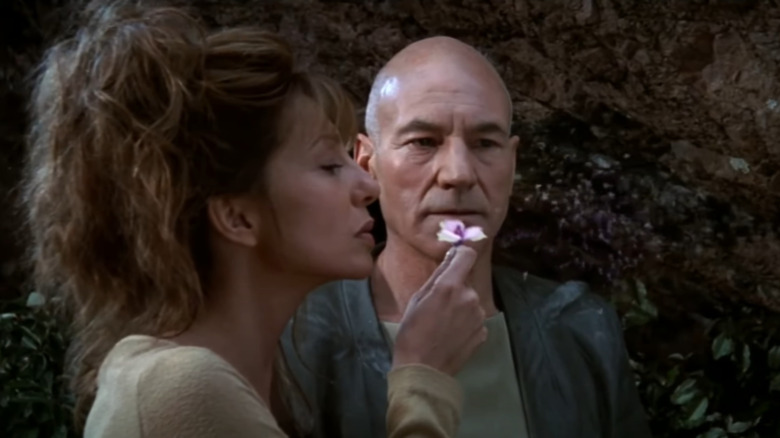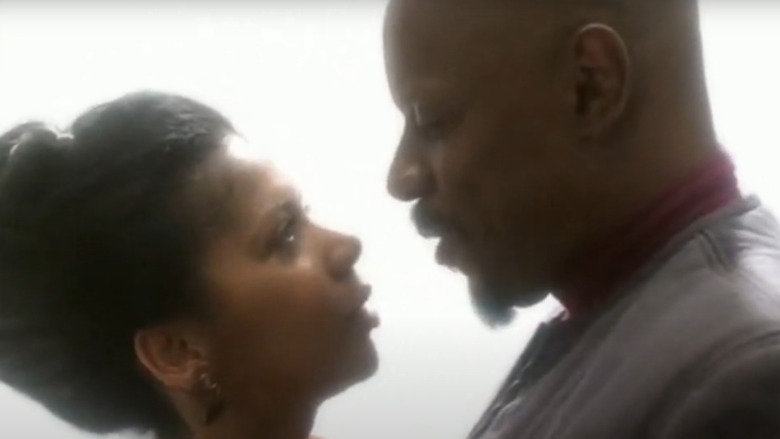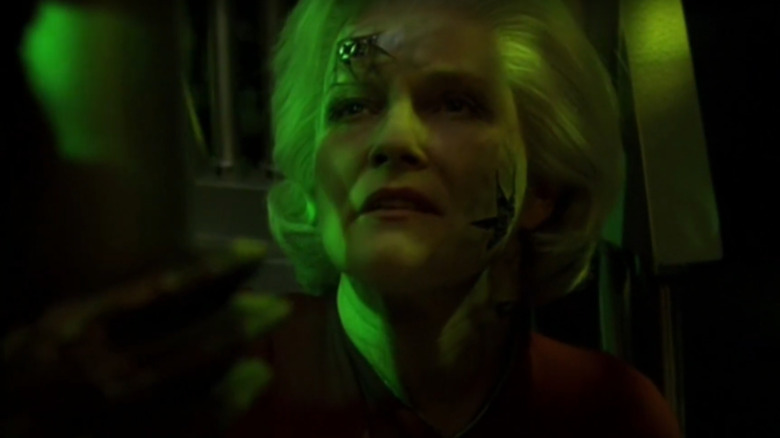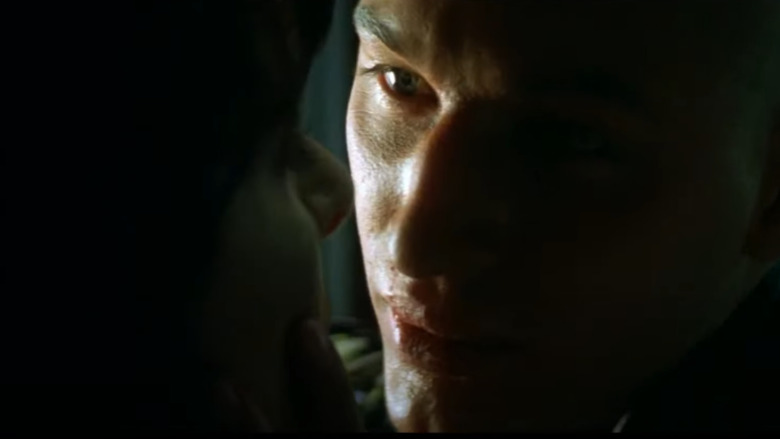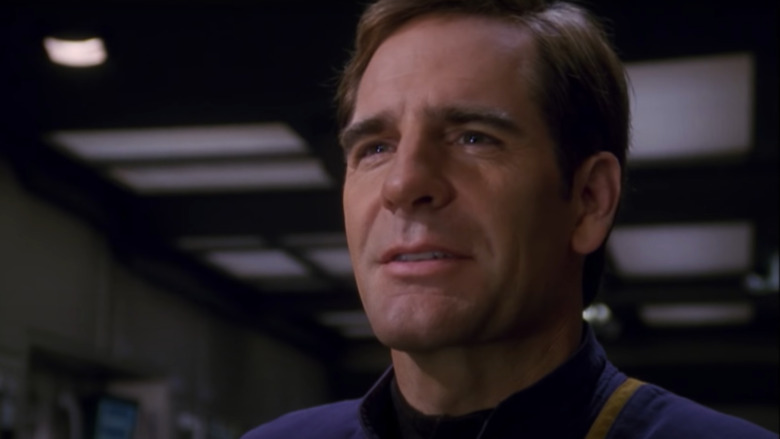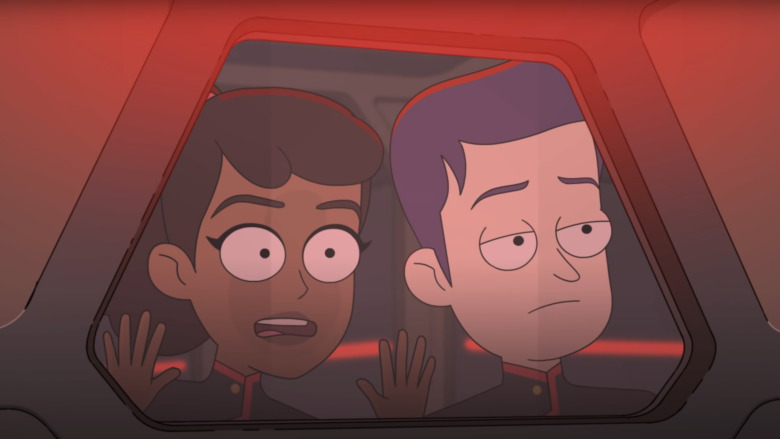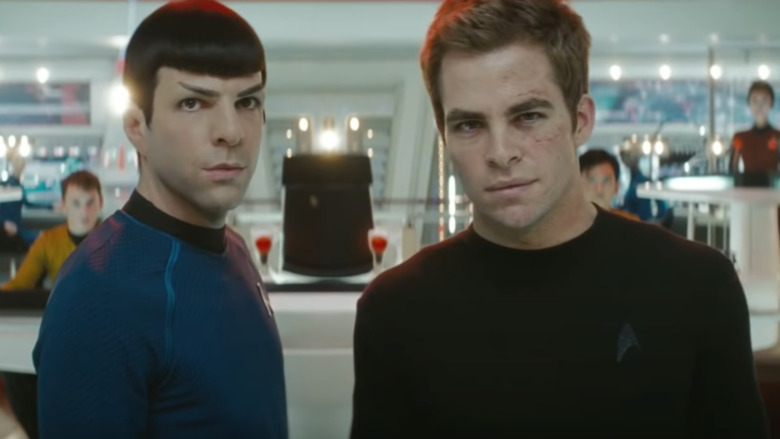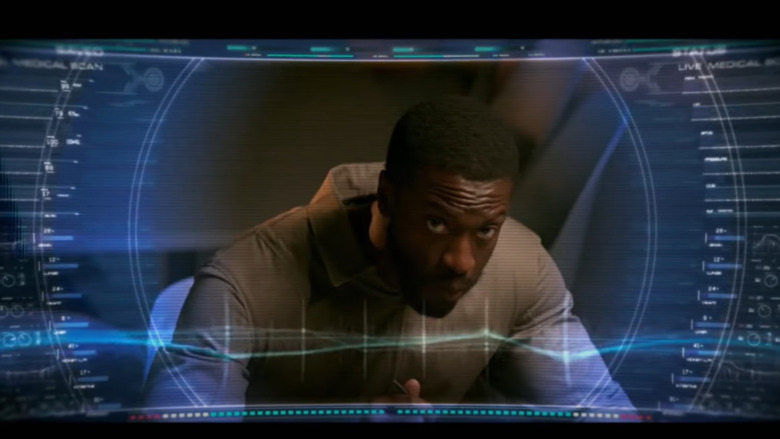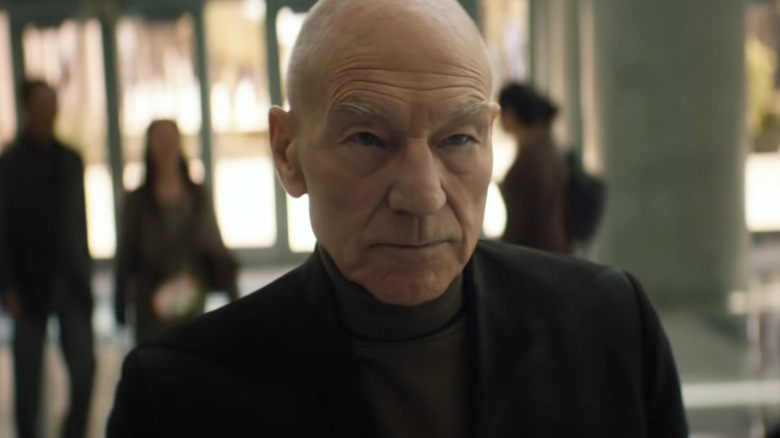This Is The Correct Order In Which To Watch The Star Trek Franchise
Don't look now, but "Star Trek" is a thing again. It's been a while — after redefining television in the 1960s and enjoying a resurgence in the '80s and '90s, the final episode of ""Star Trek: Enterprise" in 2005 marked the beginning of a dark period in which there was simply no "Trek" to be had. Then, in 2017, the drought ended with the premiere of ""Star Trek: Discovery," and when it rains, it pours. "Discovery" heralded the arrival of a whole new era of ""Star Trek," and that's just the beginning — Paramount+ will soon play host to two new "Star Trek" shows, with three more currently in development, and there's a new movie scheduled for release in 2023. Suddenly, we are awash in "Trek," which means that if you're unfamiliar with Gene Roddenberry's universe, it's a pretty good time to jump on board. Only where do you start with a franchise this big — and more importantly, what's the proper watch order?
These are the questions we're here to answer. While it's tempting to try and watch "Star Trek" chronologically, using either the fictional timeline or release dates, we recommend an order that's a bit of a blend of both. Following this list should result in an experience that provides a complete picture of what "Star Trek" is while also remaining easy to binge. With that in mind (and with the understanding that a few spoilers are unavoidable), it's time to boldly go where every previous "Star Trek" installment has gone before!
The Original Series
When you watch "Star Trek," you really need to begin at the beginning. Not with Enterprise, which is set earlier in the "Trek" timeline than any show, but with "Star Trek" — or as it's lovingly called these days, "The Original Series." This is the show that ran on NBC from 1966 to 1969, forever altering the television medium, the science fiction genre, and the experience of being a fan. While some viewers may find the special effects laughable or the political themes unsubtle, the most astonishing thing about "TOS" is how well it holds up, even more than 50 years later. The first two seasons, in particular, are absolutely riddled with classic episodes, and while the third season is significantly worse due to changes in the creative team, it's still fun to watch William Shatner ham it up as Captain Kirk, Leonard Nimoy raise a single Vulcan eyebrow as Mr. Spock, and the original Starship Enterprise soar through space. Most importantly, though, those first 79 episodes introduce rules, concepts, and even characters that "Star Trek" is still playing with today, from Class M planets and the Prime Directive to Khan and the Klingons.
The Animated Series
The unofficial fourth and fifth seasons of "Star Trek," "The Animated Series" aired on NBC from 1973 to 1974, after tempers had cooled somewhat between NBC and Roddenberry, who left "Star Trek" after its second season out of frustration with the network. Not only was the entire original cast back (minus Walter Koenig), but so was Roddenberry, and so was D.C. Fontana, Roddenberry's longtime assistant who had grown into one of the most celebrated "Trek" writers and had also departed after Season 2. Between the return of some of the show's original creative minds and cast, and the fact that animation allowed them to do so much more than live action special effects of the era, "TAS" is pure, undiluted "Star Trek."
It's never been made explicitly clear whether "TAS" is canon, but considering the number of "TAS" ideas re-used in later live-action shows, plus the introduction in "TAS" of canon pieces of backstory, like Kirk's middle name, it's silly at this point to believe otherwise. And it's required viewing for completists who want to see every televised adventure undertaken by the original Enterprise crew.
The first six films
"Star Trek: The Motion Picture" was released by Paramount in 1979, and while it's not an especially good film, it holds historical importance as the launching point for the "Star Trek" movie franchise. The real highlights in this part of the list, though, are the three films that followed. The Wrath of Khan, The Search for Spock, and The Voyage Home essentially form their own trilogy of movies within the larger "Trek" saga, and are some of the most popular and critically acclaimed installments in the franchise. "The Wrath of Khan," in particular, tends to show up near the top of "best science fiction films in history" lists, making the titular Khan such an iconic villain that he was recast for the J.J. Abrams reboot movies, while "The Voyage Home" is probably the most charming "Star Trek" film, as the Enterprise travels to the past to rescue the humpback whale species from extinction.
Even the most dedicated binge-watcher can safely skip the horrendous fifth movie, "The Final Frontier," but "The Undiscovered Country" is an absolute masterpiece, and taken together, these six films provide a worthy capstone to the franchise's inaugural era.
Discovery
It might seem counterintuitive to follow up the oldest "Star Trek" series with one of the newest, especially given that "Star Trek: Discovery" actually takes place prior to "The Original Series." But there's a good reason to jump from the tales of Kirk and Spock to the tales of Michael Burnham and...well, and Spock, who shows up in Season 2. "The Original Series" and its accompanying animated and film extensions are foundational to "Discovery," which is set shortly after the events of the rejected "Star Trek" pilot "The Cage." And characters from "The Cage" show up in Season 2 and are also appearing in their own spinoff, "Star Trek: Strange New Worlds."
While an in-universe chronological watch order would put the first two seasons of "Discovery" before "TOS" and the third season at the very end (as the crew travels forward in time to the far future) it makes more sense to us to treat "Discovery" as its own story. The third season does occasionally reference "past" events from other shows, but that does lead nicely into the next "Trek" installment...
The Next Generation (Seasons 1-5)
For many Trekkies today, "Star Trek: The Next Generation" was their introduction to the franchise, and for good reason. If any one series beyond the original can lay a claim to being the single most iconic "Star Trek" story, it's Next Generation, which premiered in 1987 and went on to not only have seven seasons of its own, but to jumpstart a chain of interlocking "Star Trek" shows that would thoroughly dominate the 1990s. Before that, though, the first five seasons of Next Generation stood alone, and if you're trying to get somebody instantly hooked on Trek, this might actually be the place to start, despite the fact that the first couple of seasons don't hold up incredibly well.
If you're absorbing all of "Star Trek," though, "Next Generation" has to be the place to start. After all, it's the next generation of what, exactly? The answer is the Starship Enterprise, which comes with an entirely new cast and crew, introducing the world to Worf, Data, Counselor Troi, and Geordi LaForge, and permanently branding the hearts of a thousand Trekkies with the image of Patrick Stewart as Captain Jean-Luc Picard.
The Next Generation (Season 6) / Deep Space Nine (Season 1)
Okay, this is where it gets weird. "Star Trek: Deep Space Nine" debuted in January 1993, just a few months after "Next Generation" kicked off its sixth season — a season full of unmitigated classics, incidentally, from the return of Montgomery Scott in "Relics" to the legendary two-parter "Chain of Command." Picard even makes a cameo in the first episode of "DS9," which takes place aboard a space station and uses the ideas and events of earlier "Next Generation" episodes to inform characters like Commander Benjamin Sisko and Quark. It's essentially impossible to understand Sisko's backstory, for example, without first having seen the "Next Generation" episode "The Best of Both Worlds."
Despite the fact that they take place over roughly the same time period, we recommend watching the entirety of Season 6 of "Next Generation" followed by the entirety of Season 1 of "DS9," if for no other reason than the former has more episodes than the latter, making it a complicated process to intercut between them. But however you choose to do it, these two seasons really should be watched back to back.
The Next Generation (Season 7) / Deep Space Nine (Season 2)
Similarly, the second season of "DS9" coincides with the last "Next Generation" season. While it might lack the standout episodes of earlier seasons, Season 7 manages a few achievements. For one thing, it puts a bow on one of the most beloved shows in television history with a flourish, ending the program with an ambitious, timeline-jumping two-parter that ties directly into the events of the very first episode. It also inadvertently lays the groundwork for a much more modern "Trek" show with an episode about junior officers called "Lower Decks." But most importantly, it ties into and reinforces "Deep Space Nine," most notably in the penultimate episode "Preemptive Strike," which deals with concurrent "DS9" problems like the Cardassians and the Maquis.
By the end of Season 2, "DS9" has already proven capable of standing on its own, having picked up and ran with the Maquis threads from earlier "Next Generation" episodes, returned to the Mirror Universe first introduced in the original series, and introduced the Dominion and the Jem'Hadar, who will serve as the series' primary antagonists. But the stories of Picard and company were far from over...
Generations
The four feature films built around the cast of "Next Generation" are a direct continuation of the movies that came before, not least because the first one, 1994's "Generations," serves as a bridge between "TOS" and its descendant, and between Kirk and Picard, in about the most literal way you could imagine. This movie marks the final appearance of several characters from the original show, including Kirk himself (the one played by William Shatner, at any rate) which makes it a crucial piece of the "Star Trek" timeline, as does the introduction of Data's emotion chip. Of course, some might consider the movie worth it just to see Malcolm McDowell chew the scenery like he hasn't eaten in three days, and we can't say they're wrong.
"Generations" launched Picard's crew onto the big screen almost immediately after their exit from the small one, meaning they would continue to be the face of "Star Trek" for the remainder of the decade. But back in the realm of "Trek" TV, things were only heating up, as a new series prepared to take the field and challenge "DS9" for television dominance.
Deep Space Nine (Season 3) / Voyager (Season 1)
Once again, it's time to switch between two seasons of "Star Trek," as the third season of "DS9" overlaps with the debuting "Star Trek: Voyager." The first "Trek" series to feature a woman (Kathryn Janeway) in the captain's chair, "Voyager" also had a unique and fascinating premise. Much of the "DS9" action is driven by the existence of a nearby wormhole that leads to the Gamma Quadrant, a section of space far away from the Federation's native Alpha Quadrant. This allows the titular space station and its intrepid crew to encounter any number of new and dangerous alien species. "Voyager" goes even farther, literally — a solitary ship finds itself transported to the even more distant Delta Quadrant and spends the rest of the series trying to get home.
Due to this premise, there's no reason whatsoever to jump between individual episodes of these two seasons, as the events of one show don't affect the other in any way. But jumping between shows by the season provides a fun and accurate experience of what it was like to watch the interlocking "Star Trek" programs of the 1990s.
Deep Space Nine (Season 4) / Voyager (Season 2)
Like most "Star Trek" shows, "Voyager" takes a couple of seasons to find its feet, and Season 2 in particular contains some of its most notoriously bad episodes, from the tone-deaf Native American implications of "Tattoo" to Janeway and Voyager pilot Tom Paris turning into salamanders and having salamander babies together in "Threshold" to the utter abomination that is "Tuvix." At least it has the consideration to get them all out of the way early on.
"DS9," meanwhile, was encountering its own problems in Season 4, which took a sharp turn away from the burgeoning conflict with the Dominion and instead spent most of its time dealing with the newly antagonistic Klingon Empire. Fortunately, even as the overarching plot went briefly off the rails, the writing was getting better and better, and the diversion is, if nothing else, entertaining. As a bonus, Season 4 features one of television's first lesbian kisses, and also brings in Worf, the Klingon security officer from "Next Generation" — until Picard, Michael Dorn was the only actor to star in the main casts of two different "Star Trek" shows.
First Contact
As a result of his dual roles, Worf would spend the next several years hopping back and forth between television and the movies. One reason it's important to watch Season 4 of "DS9" prior to watching "First Contact," the second film starring the "Next Generation" cast, is because in order to include Worf in the story, the latter is obligated to include a scene in which the Enterprise rescues another ship called the Defiant, introduced in "DS9" and captained by Worf himself. Future "Next Generation" movies, which decline in quality moving forward, come up with increasingly hand-wavy reasons for his presence on the Enterprise bridge.
"First Contact" itself, however, is by far the best of the "Next Generation" films and one of the best "Star Trek" films in general, as the crew travels back in time to prevent the cybernetic hive mind known as the Borg from altering history. Not only is "First Contact" a great movie (and the film directorial debut of Jonathan Frakes, who plays Commander William Riker), it also kicks off a spectacular "Star Trek" run that can stand up against any other period in franchise history.
Deep Space Nine (Season 5) / Voyager (Season 3)
With Season 5, "DS9" gets back on track after the previous outlier season, quickly focusing around a single unified threat thanks to an alliance between the show's original antagonists the Cardassians and the Dominion. The presence of the sinister Changelings adds an intrigue element to the story, as any character could potentially be a Changeling in disguise — a concept that would be used to great effect years later in the 2004 reboot of "Battlestar Galactica." The season concludes with the official start of the Dominion War, a conflict that would dominate the remainder of the show.
"Voyager," meanwhile, was also getting back on track in its third season, which generally sees an uptick in quality — particularly toward the end, with episodes like "Before and After," "Real Life," and "Worst Case Scenario." Robert Picardo, who plays Voyager's holographic doctor, also gets to make a cameo in "DS9" as the Doctor's creator, Lewis Zimmerman, in the episode "Doctor Bashir, I presume." And Season 3 ends with the first installment of "Scorpion," which catalyzed "Voyager's" official rise to greatness in part thanks to a memorable new character.
Deep Space Nine (Season 6) / Voyager (Season 4)
These two overlapping seasons, airing in late 1997 and early 1998, represent the pinnacle of "Star Trek's" '90s golden age. In "DS9," the Dominion War is in full swing, the series' much-discussed religions themes are building in prominence, the mysterious Section 31 is introduced, foreshadowing its prominent role in both "Enterprise" and "Discovery," and most memorably, the showrunners do what almost no iteration of "Star Trek" has ever dared to do: permanently kill off a member of the main cast.
Casting changes are also a major part of Season 4 of "Voyager," which jettisons the little-loved character of Kes and officially introduces Seven of Nine, a liberated Borg drone played by Jeri Ryan who quickly joins the ranks of the franchise's most widely known characters. It's an oversimplification to suggest that the overall brilliance of Season 4 is the direct result of Ryan joining the cast, but no matter how much of it you attribute to her, it's a phenomenal season of television, filled from start to finish with some of the best "Voyager" episodes (and also "Retrospect," but we don't talk about that one).
Insurrection
It's not "First Contact," but 1998's "Insurrection" is still a pretty good "Next Generation" movie, another solid offering from Jonathan Frakes. While "Insurrection" doesn't interact much with the events of "DS9" or "Voyager," watching it at this point in the "Trek" timeline provides an overall context for the state of the Federation, which has been intermittently challenged, as the movie's primary villain points out, by the Borg, the Cardassians, and the Dominion. A sense of the Federation being assailed from all sides isn't strictly necessary for the film's story of familial betrayal on a planet that confers immortality, but it does make viewing it a more interesting experience (though again, the perfunctory inclusion of Worf simply because he's expected to be in "Next Generation" movies is potentially jarring for "DS9" fans who have become invested in his character development, which "Insurrection" largely ignores).
"Insurrection" is Frakes' last "Star Trek" movie as director (though he would later direct episodes of "Discovery" and "Picard") and marks the beginning of the end of the '90s "Trek" boom. There's still plenty of great "Trek" ahead, but the curve is now pointing down.
Deep Space Nine (Season 7) / Voyager (Season 5)
The final season of "DS9" represents one of the single greatest creative accomplishments in "Star Trek" history, as no "Trek" show to date has managed to stick such an ambitious and satisfying landing. In a unique move, the last 10 episodes of the season form a single, series-ending story, and the feature-length finale, "What You Leave Behind," is considered one of the greatest "Trek" episodes of all time. "DS9" had been great for at least two seasons prior to this one, but the success of Season 7 cemented it as a foremost jewel in the crown of the "Star Trek" franchise.
"Voyager," meanwhile, continued its stellar run of episodes, capping off a three-year rehabilitation effort that saw one of the franchise's shakiest shows become one of its best. It was good timing, too, because with "DS9" wrapping up ("What You Leave Behind" aired the week after the Season 5 "Voyager" finale, "Equinox"), Captain Janeway and her crew were suddenly the only starship in the galaxy. And you, intrepid binge-watcher, can finally stop switching between two different shows.
Voyager (Seasons 6-7)
Unlike "DS9," the final seasons of "Voyager" are not its best, though admittedly, after Seasons 4 and 5, that's a high bar to clear. Season 6 comes close with a steady stream of classics, introducing both the popular Holodeck scenario Fair Haven and the "Pathfinder" storyline that sees "Next Generation" vets Reginald Barclay and Deanna Troi join up as recurring characters. By Season 7, however, the quality of "Voyager" has begun to dip noticeably — the final season contains few memorable episodes and at least one extremely ill-conceived romantic subplot. It earns some redemption, however, with the two-part series finale "Endgame," which, whether you like it or not, at least fulfills the promise of the show's premise and comes to a definitive conclusion about whether the ship and its crew are ever getting back to the Alpha Quadrant. It's a moment that would have been easy to shy away from, and "Voyager" meets it head on.
"Endgame" aired in May 2001, and in retrospect, the title didn't only apply to "Voyager." The continuous story that "Star Trek" had been telling for the past 14 years over the course of three different shows and three different movies was over. There was, however, one last (incredibly depressing) chapter to get through.
Nemesis
The final "Next Generation" film, released in 2002, is by far the worst of them, and the worst "Star Trek" movie in general since 1989's "The Final Frontier." It was so bad, in fact, that it notoriously killed "Star Trek" — plans for a fifth "Next Generation" movie were scrapped after "Nemesis" bombed at the box office, and creatively, it's an absolute nightmare, introducing a Romulan sister planet with the unfortunate name of Remus, blatantly attempting to restart Data's entire character arc via a literal copy with the also unfortunate name of B-4, and tying these and other unfortunate decisions together with a nonsensical plot featuring Tom Hardy as a secret clone of Picard. After "Nemesis," the scuttling of future franchise installments can honestly be seen as a mercy killing.
"Star Trek" wasn't quite dead in 2002, however. While we've now officially made it through the combined stories of "Next Generation," "DS9," and "Voyager," there's one more show, independent from the others, that now enters the viewing order. And watching it involves going back to the very beginning... and even before that.
Enterprise
In a chronological viewing, "Star Trek: Enterprise" would actually be the first show you watch, since it takes place a hundred years prior to "The Cage." Indirectly spinning off from the events of "First Contact," it tells the story of Earth's first warp starship, appropriately named the Enterprise and captained by Scott Bakula's Jonathan Archer, and of humanity's early relationships with alien species like the Vulcans, Klingons, Romulans, and Andorians. Despite its status as a prequel, the sheer degree to which "Enterprise" relies on its audience having knowledge of other "Star Trek" properties makes it almost impossible to recommend as an entry point. It fits much better here, as the official end of the franchise's second major era, especially given that the final episode, "These Are The Voyages...," frames itself as a holodeck simulation being watched by the Enterprise crew from "Next Generation."
"There Are The Voyages..." aired on May 13th, 2005. There wouldn't be another "Star Trek" show for more than 12 years. At this point, our watch order breaks away from order of release, but we feel strongly that it's how "Star Trek" from 1987 to 2005 should be watched.
Lower Decks
If you think 12 years is a long gap between "Star Trek" installments, that's nothing compared to the 45 years that went by between "Trek" stories told via animation. "Short Treks" was technically the first "Trek" show since "The Animated Series" to include animated episodes, and that aired in 2019, but 2020 gave us the first season of "Lower Decks," an entirely animated show about the people who don't get to hang out on the bridge.
The first franchise installment to ever concern itself primarily with characters who are not in command of a starship or space station, "Lower Decks" is the "Star Trek" equivalent of shows like HBO's "Harley Quinn" — an irreverent, adult-oriented comedy that revels in its TV-MA rating, delivering violence, sex, and swearing at warp speed frequencies. Chronologically, it's set shortly after the events of "Nemesis," but more importantly to the binge-watcher, it's the dessert following a feast — a vital dose of pure fun after absorbing almost four full decades of space drama.
The Kelvin timeline
After the box office failure of "Nemesis" brought an abrupt end to the "Next Generation" movies, there wasn't a new "Trek" film until 2009. And far from being a continuation of the existing movie franchise, this new version, simply called "Star Trek," was a reboot of "The Original Series," casting new, younger versions of Kirk, Spock, and the rest of the first Enterprise crew. Sequels to the reboot followed in 2013 and 2016.
Watching these three movies as part of a "Star Trek" binge is pretty much entirely optional, since they take place in an alternate timeline created when the USS Kelvin was destroyed in battle with time-traveling Romulan ship from the 24th century, leaving an infant James T. Kirk without a father in the process. Moreover, the trilogy is widely considered to be of uneven quality (though the third movie, "Star Trek Beyond," is considerably better than its predecessor, possibly due to the departure of director J.J. Abrams). Still, if you're going to watch them, this is the place in the viewing order to do it, as a key plot point of the first film — the Romulan sun going supernova — plays a major role in "Picard."
Short Treks
The Kelvin movies might not exert much direct influence over the larger plot of "Star Trek," but they played a major role in the future of the franchise by bringing in Alex Kurtzman. Kurtzman is the showrunner on "Discovery," and with the exception of "Lower Decks," he has been directly involved in every modern "Trek" series. In 2018, after the successful first season of "Discovery" led to a new expansion of the "Star Trek" franchise, Kurtzman and co-creator Bryan Fuller (formerly a writer on "DS9" and "Voyager") premiered "Short Treks," an anthology series of short, unrelated stories. As of this writing, there have been two seasons and 10 total episodes, some live-action, some animated.
"Short Treks" spans almost the entire "Star Trek" timeline — two episodes are set in the period of time between "Enterprise" and "The Original Series," while a third takes place in the far future. As a result, watching it requires a sense of the entire scope of the "Trek" universe. It's the penultimate entry in this watch order, however, because the Season 2 finale, "Children of Mars," leads directly into the final entry: "Picard."
Picard
"Star Trek: Picard" is the first of the modern "Trek" offerings to look forward rather than back, giving us a story set after the events of "Next Generation," "DS9," and "Voyager." Indeed, not only does the series follow up with Jean-Luc Picard 20 years after we last saw him (and 12 years after the Romulan sun went supernova) but it also brings in an older version of Seven of Nine, once again portrayed by Jeri Ryan. As mentioned, Picard also ties into the most recent installment of "Short Treks," which involves a terrorist attack by synthetic life forms that eventually leads to a ban on their creation — one of the many plot elements of "Picard" that has drawn criticism for being inconsistent with the original utopian vision of "Star Trek."
With so many new "Trek" shows on their way, this list will quickly become outdated. But all the upcoming series will reward previous "Trek" viewing, from Janeway's return on "Star Trek: Prodigy" to a show focused entirely on Section 31. So if you're going to binge all of "Star Trek," you might want to get started now!
